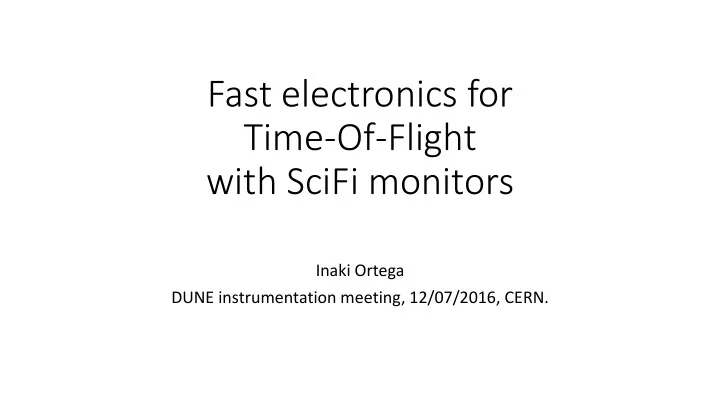

Fast electronics for Time-Of-Flight with SciFi monitors Inaki Ortega DUNE instrumentation meeting, 12/07/2016, CERN.
- The Kirchhoff Institute for Physics in Heidelberg produce an ASIC for SiPM readout, called STiC, to provide high resolution for Time-Of-Flight measurements. More information and a couple of interesting papers here: https://www.kip.uni-heidelberg.de/hep-detektoren/readout?lang=en - From the mail exchange I had with the responsible of the chip, and after explaining him how our setup looks, it is feasible to make a TOF with the SciFi monitors. Mail exchange: > the STic chip will attach timing stamps to each valid event. The > final coincidence will be done inside the DAQ. We have similar > algorithm implemented inside our system, therefore you donnot need to > worry too much.
- About the time resolution, its value depends on the time of arrival of the photons to the photo detector, the transit time spread of the photo detector and the electronics readout. The fibres are very fast scintillators with rise time and decay times of 1-2 ns. About the geometrical factor, I believe that photons inside the fibres should not arrive too spread in time. I don't imagine them bouncing back and forth, but instead, being reflected at the claddings and going almost straight to the end of the fibre. Mail exchange: >> The measured single photon timing resolution of Hamamatsu MPPC >> S13360-1350 (the one used in your first prototype) is around 50-60ps >> sigma by the STiC chip. For sure, in your system, the whole timing >> resolution is also limited by the fibers etc. But I am quite >> optimistic that your proposed number should be well reachable using >> the STiC chip.
This is a Geant4 simulation of a 30 cm length fibre, square, 1mm thickness. It shows the arrival time of photons when the fibre is excited in the middle with 1 GeV protons. There is no mirror on one side
- Our first SciFi prototype was built with SiPM, then we already have some expertise with these detectors. I propose to make a small prototype to test the ASIC: build two identical detectors of only 5 or 10 fibres, 1mm square, each one coupled to a SiPM (Hamamatsu MPPC). It could look similar to this one, but smaller:
- We would need to buy the evaluation board. The STiC team proposes to establish a kind of collaboration: >> Concerning the "purchasing" part, instead of "Selling Product", we >> would propose to have certain collaboration contract between >> CERN/EPFL and Heidelberg. We will deliver the evaluation kit to you >> and the related support during your evaluation as well. The cost >> will also be stated in the contract. For the kit, it costs 5000EURO >> and the related manpower for the support will be, according to the >> status later, around 2-3K EURO for trips to CERN. The contract will >> then be valid particularly for your evaluation process. For sure, >> the cost can be negotiated and discussed. I hope you can also >> agree on this type of "payment".
That’s all for the moment. Thanks for listening!
Recommend
More recommend